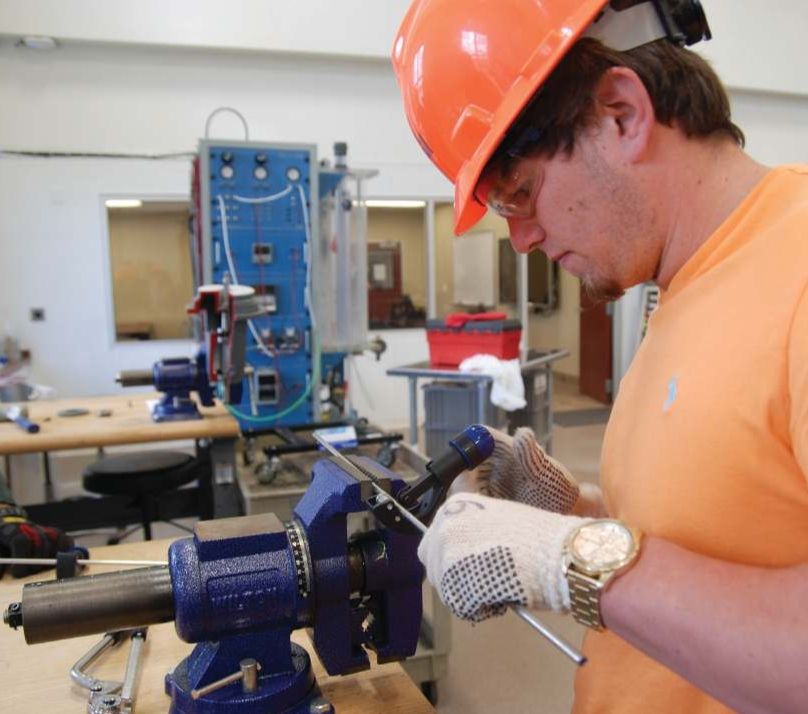CALENDAR
September 29, 2015
Cancelling card doesn’t erase your credit history
September 29, 2015Fletcher Technical Community College is meeting the workforce needs of the oil and gas industry through collaboration with energy companies in developing industry-specific training.
Fletcher’s associate of applied science program produces graduates that are certified deepwater production operators. These operators generally end up working offshore on drilling rigs or oil production platforms, but may also work in the petro-chemical industry because many of the skills they learn translate easily into that industry, according to Crystal Chiasson, workforce development coordinator at the Integrated Production Technologies Building.
The building is the product of collaboration between Fletcher and the industry to create a place where students are exposed to the equipment they will use every day in their careers.
The 30,000-square-foot building sits on the Fletcher campus in Schriever. It is equipped with 10 classrooms, half of which are computer classrooms and the others lecture rooms.
The facility also includes a 4,000-square-foot lab with more than $1 million worth of lab equipment. The equipment is all technology used offshore.
The lab is lined with bench-scale production equipment, such as a three-phase oil extractor and waste-water separator that students use to learn the mechanics behind the processes involved in the oil and gas industry.
The facility cost $8 million to build, half of which was paid by the State of Louisiana and the other half by BP America Inc.
“As you walk down the rows, each one of those things represents a piece of equipment they will encounter offshore,” Fletcher Interim Chancellor Earl Meador told The Times in a previous interview as he pointed down a row of pumps, valves, hydraulic systems and just about every other piece of oil rig equipment.
“We take students who have maybe never seen a machinery environment or even used a screwdriver or wrench in their lives. [By the end of the course], they have to be competent and comfortable,” he said.
Many of those students eventually work for energy giants. Currently, Fletcher has internship programs with Shell Oil Company and Anadarko Petroleum Corporation, Chiasson said. Fletcher is currently trying to set up internship programs with other companies, but that will take time to finalize, she said.
Most students in the applied sciences program attend classes at night because they work during the day, Chiasson said. Although Fletcher doesn’t track how many of its students already work in the oil and gas industry, instructors say between 15 and 20 percent of students are already doing so.
One of those students is Megan Robinson, a freshman at Fletcher who currently works as a helicopter coordinator for Noble Energy. Robinson hopes to get a higher paying position with the company after earning her applied sciences degree.
“There are a lot of people in the industry that have [come] through here to further their positions and go for the higher-paying positions,” Robinson said as she cut stainless steel tubing for a class assignment.
Many graduates end up working for Shell or Anadarko, but also Danos, Inter Tech, BP America, Schlumberger, Wood Group, Oceaneering International, PDI Solutions and Ardent Eagle Solutions, to name a few.
“Even some people have gone to work for Terrebonne [Parish] Consolidated Government at the Water Works,” Chiasson said. “Because some of the equipment in [the lab] is used at the plant.”
It’s no surprise that graduates of the applied sciences program end up working for such high profile companies since the Integrated Production Technologies Building houses the Deepwater Center for Workforce Excellence.
The designation was given by the Louisiana Board of Regents and brings industry leaders and college administrators together to create curriculum and academic standards that will generate the best offshore specialists possible, said Jessica Thornton, executive director of Institutional Advancement.
Those standards require that students fully understand and grasp complex concepts that are better learned through animation.
For example, director of research and development Steven Lee uses software programs 3D Max and Real Flow to demonstrate in-depth analysis of how fluids flow through piping and pumps as well as how mechanical equipment operates.
“A lot of people do 3D, but fluid animation is not so common at all,” Lee said. “The fluid simulation has dozens of parameters like viscosity, density, specific gravity, internal and external pressures and internal and external temperatures. There are a lot of physics and mathematical algorithms. You end up with something that looks quite real.”
Professors have access to gigabytes of ready-made animations for concept demonstrations and can request a custom one from Lee.
Fletcher is adding another impressive feature to the IPT building, as well. Construction has just begun on an oil production platform alongside the building where students will be able to apply their newly acquired skills to a quasi-real world environment, Chiasson said.
The platform will be elevated and will have all of the equipment students will encounter offshore, she said. It will behave like a real offshore platform.
“It serves as an example of our commitment to teaching our students the theoretical world in there,” Chaisson said as she pointed toward the lab, “and the real world as well.”
Fletcher junior Daniel Long practices cutting stainless steel tubing during class at the BP Integrated Production Technologies laboratory last week. Students are taught essential skills for working in industries ranging from oil production to petro chemical.










